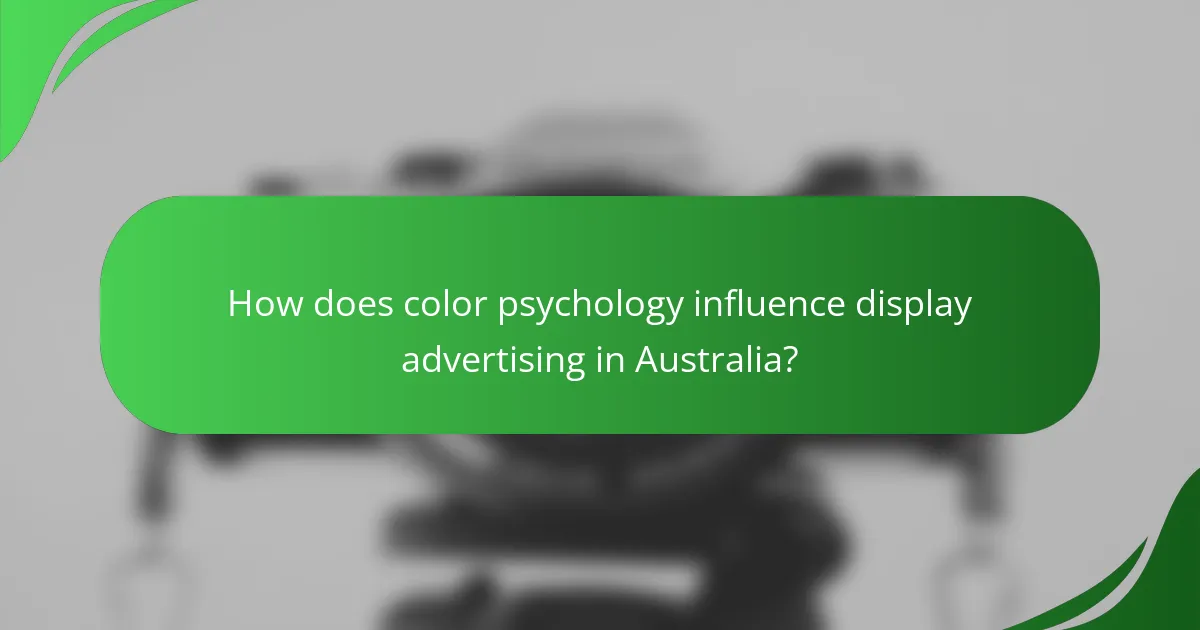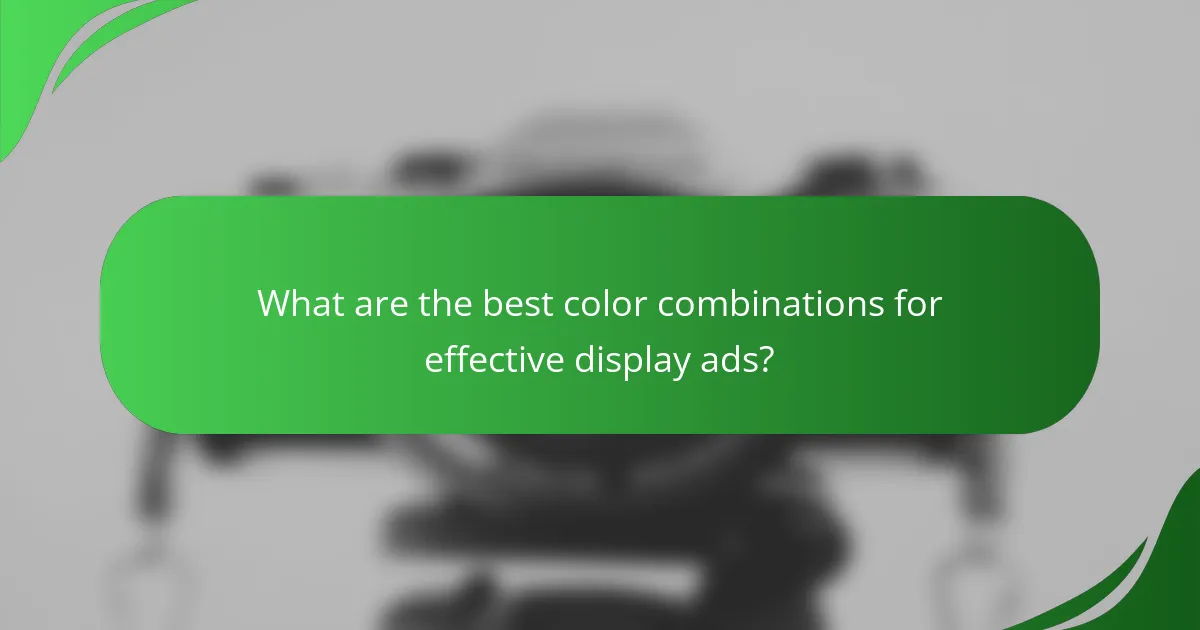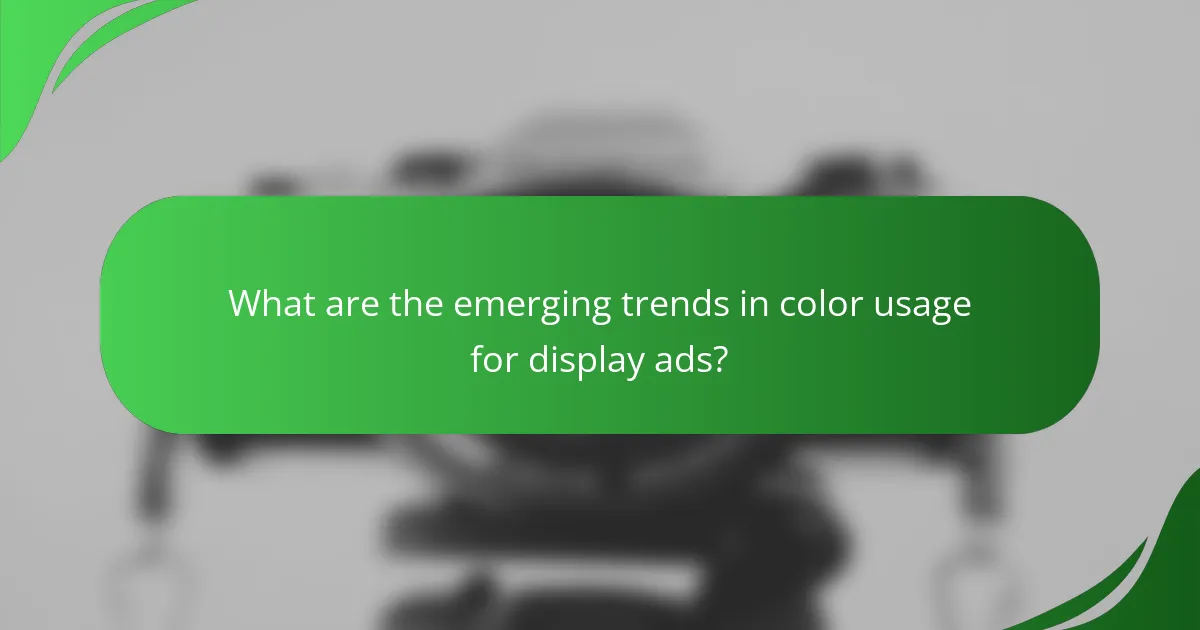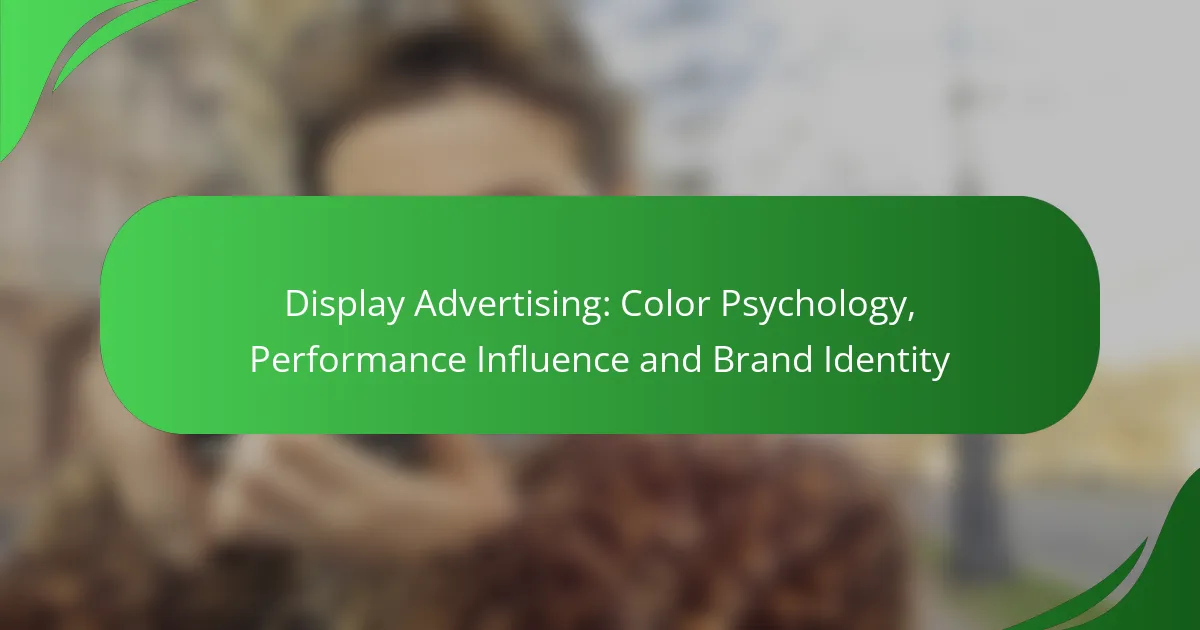Color psychology plays a crucial role in display advertising by influencing consumer emotions and perceptions of brands. By strategically selecting color combinations, marketers can enhance user engagement and strengthen brand identity, ultimately impacting purchasing decisions. Understanding the emotional associations of different colors allows brands to tailor their advertising efforts to resonate more effectively with their target audience.

How does color psychology influence display advertising in Australia?
Color psychology significantly impacts display advertising in Australia by shaping consumer emotions and perceptions of brands. Marketers must consider how different colors evoke specific feelings and associations, which can ultimately influence purchasing decisions.
Impact of warm colors on consumer emotions
Warm colors, such as red, orange, and yellow, tend to evoke feelings of excitement, warmth, and urgency. These colors can stimulate appetite and encourage quick action, making them effective for promotions and sales. For instance, a red call-to-action button may increase click-through rates by creating a sense of urgency.
However, overusing warm colors can lead to feelings of aggression or anxiety. It’s crucial to balance these colors with neutral tones to maintain a positive emotional response while still driving engagement.
Effects of cool colors on brand perception
Cool colors like blue, green, and purple are often associated with calmness, trust, and professionalism. Brands that utilize these colors can enhance their credibility and foster a sense of reliability among consumers. For example, many financial institutions use blue to convey stability and security.
While cool colors can create a soothing effect, they may also be perceived as distant or unapproachable if not used thoughtfully. Combining cool colors with warmer accents can help maintain a welcoming brand image.
Color associations in Australian culture
In Australia, certain colors carry specific cultural meanings that can influence advertising effectiveness. For instance, green and gold are strongly associated with national identity and pride, making them effective for campaigns aimed at promoting local products.
Additionally, colors like red can evoke feelings of excitement and energy, aligning well with outdoor and adventure-themed brands. Understanding these cultural associations is essential for creating resonant advertising that connects with Australian consumers.

What are the best color combinations for effective display ads?
The best color combinations for effective display ads often involve high-contrast schemes that grab attention and complementary colors that reinforce brand identity. Choosing the right colors can significantly influence user engagement and perception of your brand.
High-contrast color schemes
High-contrast color schemes are essential for making display ads stand out. These combinations, such as black and yellow or blue and white, draw the viewer’s eye and enhance readability. Aim for a contrast ratio of at least 4.5:1 for text against backgrounds to ensure visibility.
When using high-contrast colors, be mindful of the emotional response they evoke. For instance, red and white can create urgency, while blue and orange can convey trust and excitement. Test different combinations to see which resonates best with your target audience.
Complementary colors for brand identity
Complementary colors, which are opposite each other on the color wheel, can effectively strengthen brand identity. For example, pairing blue with orange or green with red can create a vibrant and memorable visual impact. This approach helps reinforce brand recognition as users associate specific colors with your business.
When selecting complementary colors, consider your brand’s personality. A tech company might opt for blue and orange for a modern feel, while a wellness brand might choose green and pink for a calming effect. Consistency across all marketing materials is crucial for building a cohesive brand image.
Color harmony and visual appeal
Color harmony refers to the pleasing arrangement of colors that creates a balanced and attractive visual experience. Using analogous colors—those next to each other on the color wheel—can create a soothing effect, while triadic schemes, which use three colors evenly spaced, can add vibrancy and energy.
To achieve color harmony, consider the 60-30-10 rule: use 60% of a dominant color, 30% of a secondary color, and 10% of an accent color. This balance helps maintain visual interest without overwhelming the viewer. Regularly review your ads to ensure color harmony aligns with your brand’s message and audience preferences.

How can brands leverage color psychology for better performance?
Brands can enhance their performance by strategically using color psychology to influence consumer emotions and behaviors. By understanding how different colors evoke specific feelings, brands can tailor their advertising to resonate more effectively with their target audience.
Case studies of successful campaigns
Several brands have successfully utilized color psychology in their advertising campaigns. For instance, Coca-Cola’s use of red is linked to excitement and energy, reinforcing its brand identity and driving impulse purchases. Similarly, the calming blue of Facebook promotes trust and encourages user engagement, contributing to its massive user base.
Another example is the fast-food chain McDonald’s, which uses yellow and red to stimulate appetite and create a sense of urgency. These color choices have been integral to their branding, leading to increased foot traffic and sales.
Color testing and optimization strategies
To optimize color usage, brands should conduct A/B testing to determine which colors resonate best with their audience. This involves creating multiple versions of ads with different color schemes and measuring engagement metrics such as click-through rates and conversion rates.
Additionally, brands can utilize tools like heat maps to analyze user interactions with various color elements on their websites. This data helps in refining color choices to maximize visual appeal and effectiveness.
Measuring color impact on click-through rates
Measuring the impact of color on click-through rates (CTR) involves tracking user behavior and engagement metrics. Brands should monitor changes in CTR when implementing new color schemes in their ads or websites, noting any significant fluctuations.
Common practices include setting up analytics tools to assess performance over time and comparing results against industry benchmarks. A well-executed color strategy can lead to improvements in CTR by as much as 20-30%, depending on the context and audience.

What are the key factors in choosing colors for display advertising?
Choosing colors for display advertising involves understanding how colors influence perception and behavior. Key factors include the target audience’s demographics, alignment with brand values, and industry-specific color trends.
Target audience demographics
Understanding the demographics of your target audience is crucial when selecting colors for display advertising. Different age groups, genders, and cultural backgrounds may associate specific colors with varying emotions and meanings. For example, younger audiences might respond positively to vibrant colors, while older demographics may prefer more muted tones.
Consider conducting surveys or focus groups to gauge color preferences among your audience. This can help tailor your advertising colors to resonate more effectively with potential customers.
Brand values and messaging alignment
Your color choices should reflect your brand’s core values and messaging. For instance, a brand that emphasizes sustainability might use earthy tones like greens and browns, while a tech company may opt for sleek blues and grays to convey innovation. Consistency in color usage strengthens brand identity and recognition.
Ensure that the colors you choose not only align with your brand’s message but also evoke the desired emotional response. This alignment can enhance the overall effectiveness of your display advertising.
Industry-specific color trends
Each industry often has established color trends that can influence consumer expectations. For example, the food and beverage industry frequently uses warm colors like red and orange to stimulate appetite, while the healthcare sector tends to favor blues and greens for a calming effect. Being aware of these trends can help your advertising stand out while still feeling familiar to consumers.
Researching competitors and analyzing successful campaigns within your industry can provide insights into effective color choices. This knowledge can guide your decisions and help you avoid common pitfalls associated with color selection.

How does color affect brand identity in display advertising?
Color plays a crucial role in shaping brand identity in display advertising by influencing consumer perception and emotional response. A well-chosen color palette can enhance recognition, convey values, and differentiate a brand in a crowded market.
Consistency in color usage across platforms
Maintaining consistent color usage across various platforms is essential for reinforcing brand identity. When consumers encounter the same colors on websites, social media, and advertisements, it strengthens their recognition and trust in the brand.
For effective consistency, brands should establish a clear color palette and guidelines for usage. This includes primary and secondary colors, as well as specific shades, ensuring that all marketing materials align visually.
Color as a brand differentiator
Color can serve as a powerful differentiator in display advertising, helping brands stand out from competitors. Unique color choices can create a distinct visual identity that resonates with target audiences and sets a brand apart.
For example, brands like Coca-Cola use red to evoke excitement, while Tiffany & Co. employs a specific shade of blue to signify luxury. Such strategic color choices can become synonymous with the brand itself, making it instantly recognizable.
Psychological effects of brand colors
Different colors evoke various psychological responses, which can significantly impact consumer behavior. For instance, blue is often associated with trust and reliability, making it a popular choice for financial institutions.
Brands should consider the emotional implications of their color choices. Conducting market research to understand target audience preferences can guide effective color selection, ensuring that the chosen colors align with desired brand attributes and consumer expectations.

What are the emerging trends in color usage for display ads?
Emerging trends in color usage for display ads focus on personalization, dynamic adjustments, and the integration of artificial intelligence. Advertisers are increasingly leveraging these trends to enhance user engagement and brand identity.
Personalization and dynamic color adjustments
Personalization in display ads involves tailoring color schemes to individual user preferences and behaviors. Dynamic color adjustments can change based on factors like location, time of day, or user interaction, making ads more relevant and appealing.
For example, a retail ad might use warmer colors during the evening to evoke a cozy feeling, while cooler tones may be used during the day for a refreshing effect. This approach can significantly boost click-through rates and conversions.
Influence of AI on color selection
Artificial intelligence is revolutionizing color selection in display advertising by analyzing vast amounts of data to determine which colors resonate best with target audiences. AI algorithms can predict user preferences based on demographics and past interactions.
For instance, an AI tool might suggest using blue tones for a financial service ad aimed at young professionals, as studies show this demographic often associates blue with trust and reliability. This data-driven approach helps optimize ad performance.
Future color trends in digital advertising
Future color trends in digital advertising are likely to emphasize bold and vibrant palettes, reflecting a shift towards more expressive branding. As consumers seek authenticity, colors that convey emotions and values will become increasingly important.
Additionally, sustainability themes may influence color choices, with earthy tones gaining traction as brands align with eco-friendly practices. Advertisers should stay ahead by experimenting with color combinations that not only attract attention but also resonate with their brand ethos.



